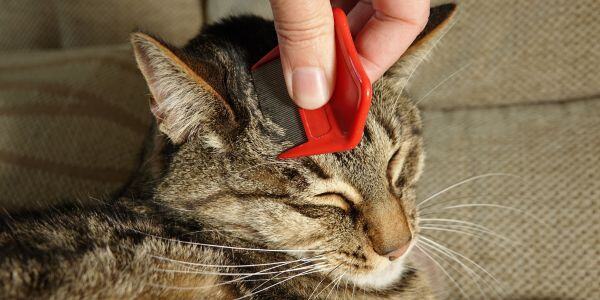
I am sure when I was young and in school, I said the snarky comeback, "Girls can do anything boys can do."
Many people often try to apply that same sentiment about "boys and girls" to cats and dogs. And while pets may seem like they are very similar and can do a lot of the same things, the reality is, ‘cats are NOT small dogs.’
This was repeatedly drilled into us at veterinary school as a reminder that cats and dogs cannot be treated the same, especially with regard to medications. What may save one could potentially kill the other.
This is especially true with regard to flea prevention products. Even though some over-the-counter (OTC) products are labeled for cats, they can still have potentially toxic effects because some cats are especially sensitive to the ingredients or the product isn't used as directed. But even more potentially dangerous is if you accidentally or intentionally apply DOG flea or tick preventative to your cat.
Key Takeaways (TL/DR)
1. DO NOT APPLY DOG FLEA & TICK PREVENTATIVES TO CATS: The ingredients in dog flea and tick products are highly toxic and even fatal if used on cats. Use a proven and tested flea product specifically made for cats
2. Use Preventatives Year-Round: With warmer winters, cooler summers, and a surge in bugs during these months when we didn't usually see any, we can no longer predict these parasites’ behavior. It is not recommended you skip any preventative doses anymore, even when it may be cold outside. Find out why skipping doses isn't a good idea
3. Fleas Are More Than a Nuisance: Fleas can cause trauma to your cat’s skin, as well as cause allergic reactions in some cats (known as flea allergy dermatitis). They can also carry tapeworms, a nasty intestinal parasite. If that isn't bad enough, they can also transmit diseases, such as plague, typhus, and cat scratch disease (CSD) to humans. Read why indoor cats need preventatives too
4. Flea Infestations Are Challenging: You have to treat and bathe your pet, clean your home, and control the infestation outside your home as well. Learn how to get rid of the infestation effectively
5. If You Have More Than One Pet, They All Have to Be Treated for Fleas: If you have one pet that has fleas, it's likely all your pets are infected, so you'll need to treat all of them in order to get the infestation cleared.

Why Dog Flea & Tick Preventatives Should Never Be Used on Cats
I will say it again: cats are NOT small dogs. Their metabolisms and internal systems work very differently. Please trust me when I say this: when you use flea and tick medications not intended for cats on a cat, the effects can be disastrous. Nothing is more heart-wrenching than seeing a cat suffering with tremors or having seizures due to dog flea and tick preventatives. Watch this video to see those effects on a poor cat after he came in contact with a dog flea preventative from the store.
Pyrethrins and the related — but more potent — chemically-derived pyrethroids are widely used insecticides in flea and tick prevention products used around homes and on our pets. They kill insects by preventing their nervous system from functioning properly. However, these products are not species-specific and can cause severe and significant neurologic problems when applied to certain pets — specifically cats.
Cats lack the liver enzymes necessary to process these compounds safely. The result can be fatal in some cases. Read more about pyrethrin toxicity in cats.
Safe and Effective Flea Treatment Products for Cats
If you have a cat or multiple cats and would like to avoid pyrethrin/pyrethroid-based products, below are some safer, effective flea control products for cats.
We didn’t include any over-the-counter (OTC) medications, as many are not as effective or safe in every circumstance. For more information on the benefits of prescription preventatives over OTC ones, you can check out our article on over-the-counter vs. prescription flea and tick preventatives for more information.
Please note that these products have been tested as being safe for cats. However, every cat is unique, and with every medication, there is always a risk of an adverse reaction. This is especially true when the products are not given as directed.
-
Advantage® II: for cats 8 weeks and older, kittens weighing 2–5 lbs, and cats weighing 5–9 lbs, or over 9 lbs; topical liquid; lasts up to a month
- Advantage® XD: for cats 8 weeks and older, weighing 1.8–9 lbs or over 9 lbs; topical liquid; lasts up to 2 months
-
Advantage MULTI®: for cats 7 weeks and older, weighing more than 2 lbs; requires a prescription; topical liquid, also protects cats from heartworms, ear mites, and some types of intestinal worms; lasts up to a month
-
Bravecto®: for cats 6 months and older and weighing more than 2.6 lbs; requires a prescription; topical liquid, also protects cats from certain tick species; lasts up to 3 months
-
Bravecto® PLUS: for cats 6 months and older and weighing 2.6 lbs and more; requires a prescription; topical liquid, also protects cats from heartworms, certain tick species, and some types of intestinal worms; lasts up to 2 months
- Catego®: for cats 8 weeks and older and weighing more than 1.5 lbs; topical liquid; lasts up to a month
-
Cheristin®: for cats 8 weeks and older and weighing more than 1.8 lbs; topical liquid; lasts up to 6 weeks but monthly application is recommended
-
Comfortis™: for cats 14 weeks and older and weighing 4.1–6 lbs; 6.1–12 lbs; 12.1–24 lbs; chewable tablet; lasts up to a month
-
Revolution® PLUS: for cats 8 weeks and older and weighing more than 2.8 lbs; requires a prescription; topical liquid, also protects cats from heartworms, ear mites, certain tick species, and some types of intestinal worms; lasts up to a month
-
Seresto®*: for cats 10 weeks and older; collar, also protects cats from certain tick species; lasts about 8 months
- Vectra®: for cats 8 weeks and older and weighing 2–9 lbs or over 9 lbs; topical liquid; lasts up to a month
*This collar has a safety release mechanism, but not all flea collars do. However, cats with a weakened state or those with arthritis in the neck may not be strong enough to sufficiently widen the collar to allow it to release if the cat is trapped.
Is Frontline® Plus Safe for Cats?
Frontline Plus is safe and was one of the first flea preventatives available. It isn't included on our list above since its effectiveness over time has decreased significantly, and it has been noted that some flea strains have variable responses. However, research does not show direct evidence of resistance by fleas to the active ingredient fipronil.

Safe Use of Flea & Tick Preventatives
-
Only use products that are appropriate for your cat's age and weight.
-
Be sure to carefully read the label on whatever product you select and ONLY use it as directed. Depending on the product, it will be administered monthly or every three months.
-
Chewable tablets should be given just before or just after eating (within 30 minutes) for maximum effectiveness.
-
Topical applications should not be applied within 48 hours of a bath, before and after application. It should be applied in a location where your cat cannot lick it off. Personally, I do not like applying all the topical treatment in one spot. I have seen cats develop irritation at the site and hair loss. I prefer to make a long part in their hair starting at the neck and slowly apply the treatment on the skin, extending the part until all the product is used. Gently fluff the hair back over the part, then distract your kitty with treats and play until it dries. Enjoy a good game of "hunting" with your cat.
-
Collars must be applied tight enough to activate them. Flea/tick collars are not always breakaway collars or have safety buckles, which means they can be a potential choking hazard if they get caught on something. Additionally, they can cause irritation to the skin.
Your Veterinarian Will Help You Choose the Best Flea Treatment for Your Cat
There are several factors your veterinary team will take into account when helping you select the best flea/tick preventative for you and your cat. In addition to the basics such as their age, breed, and weight, these include:
Location: What region you’re located in, and the impact these environments/temperatures have on fleas and ticks, and other parasites. City areas may have more rodents, which means more exposure to fleas.
Housing type: Your cat is more at risk for fleas, living in an apartment or duplex where other pets live and may not be on flea preventatives.
Lifestyle: Your cat’s lifestyle – are they indoor-only, or are they allowed outside or are they exposed to pets that go outdoors? If so, is this outdoor space controlled (i.e., a backyard, or are they on a leash?), or do they or other pets roam freely?
Your family: Do you have children or other pets, their ages, and do they interact with your cat?
Travel: Do you travel with your cat? Domestic or international travel? If so, how often and where to?

Treating Fleas at Home
Although it is still possible for fleas to try and take over your home (and your cat!), if you have your cat on an effective flea preventative such as one prescribed by your veterinarian year-round, the chance of this occurring is much less likely.
Additionally, your veterinarian may use these preventatives in combination with other products to treat fleas should you miss a dose and an unfortunate flea infestation occurs.
Furthermore, it is important if you have additional pets in your home to make sure they are all on safe and effective flea preventatives as well.
Speaking about other pets, if your cat has fleas, likely, your other pets do too, so they will all need to be treated.
To get rid of fleas at home, you’ll need to:
-
Use the preventative product your veterinarian gave you as directed and use it on an ongoing basis (every single month)
-
If you feel the need, use a flea comb to remove live fleas and their eggs (this step isn't necessary as the fleas and eggs will die and fall off)
-
Bathe your cat with a non-irritating shampoo (wait until after 48 hours if you are using a topical flea medication), such as Veterinary Formula Clinical Care Hypoallergenic Shampoo or Dechra DermaLyte Shampoo. In a pinch, Dawn works too.
Note: You don't need to use a flea-specific shampoo because you have already used a product to kill fleas. These shampoos can potentially strip away your topical flea product, and some cats can be sensitive to the ingredients in some flea shampoos.
Note: Remember to clean your cat's ears with an ear cleaner following a bath to prevent an ear infection. Here are some safe ear cleaners to use on your cat. -
Wash everything fabric in HOT water (including cushion covers, bedding, etc.)
-
Vacuum everything (e.g., curtains, furniture, hardwood floors, etc.) that can’t be washed by hand or in a machine
Tips: Cut up an inexpensive flea collar (just for this purpose – not to use on your cat) and put it in the dirt collection part of your vacuum or in the vacuum bag. Be sure to completely empty the vacuum contents into a trash bag after every vacuuming session and haul it far away from your home!
Note: The crevices between the planks of flooring are an ideal spot for flea eggs. Therefore, it is important to vacuum hardwood and laminate flooring.
Note: If you are going to use an environmental flea treatment, such as an aerosol or powder, in your home, be sure to vacuum just prior — since vacuuming encourages flea eggs to hatch and makes them susceptible to the treatment. - Repeat vacuuming daily or every other day until the infestation is under control. This typically takes 3 to 8 weeks.
For more detailed instructions on getting rid of fleas in your home and outside, check out our tips here.
Why Flea and Tick Preventatives Should Be Used All Year Long
The older school of thought was that fleas and ticks weren’t as active in the winter months. Therefore, it wasn’t necessary to use preventatives during these periods, with saving money as the only real benefit.
However, with more recent climate changes, we have seen warmer winters, cooler summers, and a surge in bugs during these months when we normally wouldn’t see any. Because we can’t predict these parasites’ behavior, it is not recommended you skip any preventative doses anymore, even when it may be cold outside.
Why Skipping a Dose Isn’t a Good Idea
Just like when we are prescribed a medication, we are advised not to skip any doses. The same goes for our pets, including their preventatives. It should be noted that a product will only be effective for as long as the manufacturer states, which is typically one month for most preventative products (depending on the product). Therefore, strict compliance is necessary if you wish to maintain a parasite-free home and cat.
Once a preventative has lapsed, it can take on average 24–48 hours for the next dose to start working and to re-start any protection for your cat. The period between protection lapsing can be critical, and it only takes this window for a flea to sneak in and start an infestation — an adult female flea can lay 40 to 50 eggs a day!
And this is only one of the reasons veterinarians and veterinary staff promote the use of flea prevention products before fleas can become an issue. Not only are flea infestations difficult, time-consuming, and frustrating, but fleas can cause trauma to your cat’s skin, as well as cause allergic reactions in some cats (known as flea allergy dermatitis). They can also carry tapeworms, a nasty intestinal parasite. If that isn't bad enough, they can also transmit diseases, such as plague, typhus, and cat scratch disease (CSD) to humans.
Why Indoor-Only Cats Need Parasite Preventatives
We can’t forget our indoor-only feline friends. Although many may live in high-rise apartments, and it may seem that they are much less likely to come into contact with fleas or other parasites, you’d be surprised! Indoor plants can attract all kinds of bugs (including fleas), or if you have a dog, then you 100% have a flea magnet in your home.
However, just by you’re going outside into the world, this is enough for you to bring back 1 flea (and that’s ALL that it takes!) to start a flea party in your 6-floor NYC walk-up and reason enough to have your indoor kitty on flea preventatives.
Simply put, preventing fleas and other parasites is far better than trying to eliminate them once they’ve made their way onto your cat and into your life.
Alternative Cat Flea Prevention
Fleas and other parasites can be frustrating, to say the least, especially when it comes to finding the right treatment or prevention protocol for your cat and household. Generally, people may end up integrating a combination of treatments — be it a veterinarian-recommended treatment, an environmental treatment, or alternatives.
We did some research on alternatives and came across some of the slightly less common treatments out there and wanted to share with you what we found:
-
Borax: The active ingredient is boric acid, and it kills fleas and flea larvae by dehydrating them. It is not known to eliminate flea eggs – therefore, additional treatment is needed. As a pre-treatment, it can be sprinkled on carpets and then a stiff brush is used to work it into the carpet. The borax is left on the carpet for a minimum of 6 hours but not longer than 2 days. DO NOT allow children or pets on the treated area. Then vacuum. All contents that were removed via vacuuming need to be discarded.
Borax is not safe for use by pregnant women. It can cause severe breathing problems if used around cats, and it must never be applied directly to pets. It should never be put on a pet’s bedding. Fleas live around houseplants, but you cannot use borax near them as it can be toxic to plants.
-
Black walnut: Administered orally several times a week (for life!) in capsules or liquid form as a preventative. However, black walnut is TOXIC at high doses. Therefore, this is NOT recommended. It also sounds very intense, having to medicate a cat several times a week.
-
Diatomaceous earth: A powder composed of the fossilized remains of single-celled algae that is sprinkled on carpets to get rid of a flea infestation and then vacuumed up. Known to be harmless if ingested; however, it is toxic to your cat if inhaled.
Also, please DO NOT apply it to your cat’s body directly. All pets should be removed from the home if you choose to use this powder, and you should also wear a protective mask. And this option alone won’t get rid of the fleas on your cat.
-
Homemade sprays: They may smell great, but their efficacy has not been proven and cannot easily be tested scientifically across many cats. Additionally, some of the DIY flea sprays we found can cause more harm than good when used around cats.
A typical recipe we found in a few places online, but cannot attest to if it works, is to add five drops each of tea tree oil, citronella oil, rosemary oil, peppermint oil, and eucalyptus oil to one cup of water, shake it, and put it in a spray bottle. However, there are many other recipes out there.
Essential oils need to be used in a very dilute form, if at all, around cats. They are very sensitive to them, and some can be toxic, like the tea tree, citronella, and (some types of) peppermint oils in the above recipe! Additionally, these are designed to be used in your cat’s environment and NOT to be sprayed directly on your cat as they can be toxic and harmful if ingested or inadvertently sprayed in their eyes or mouth. Eugenol oil (also known as clove oil), found in some commercially produced flea/tick products, can also be toxic to cats unless used as directed. -
A good ol’ bowl of water & dish soap: This home flea remedy involves creating a flea trap using dish soap and some water. By filling a plate or bowl with a mixture of warm water and dish soap, you then place this potion in the areas of your home that have the most flea activity. This solution acts as a glue, trapping the fleas due to the high viscosity of the solution. You should replace the water/soap trap daily, and it works best at night-time as fleas are nocturnal. Some suggest using a candle near the solution enhances this remedy. However, this is not advised due to the potential fire hazard. It should be noted that this does NOT prevent fleas from biting or infesting your pets and may put your pets at risk for drinking water containing dish soap.
Let us know, in the comments below, how you protect your cat from these horrible little pests.



